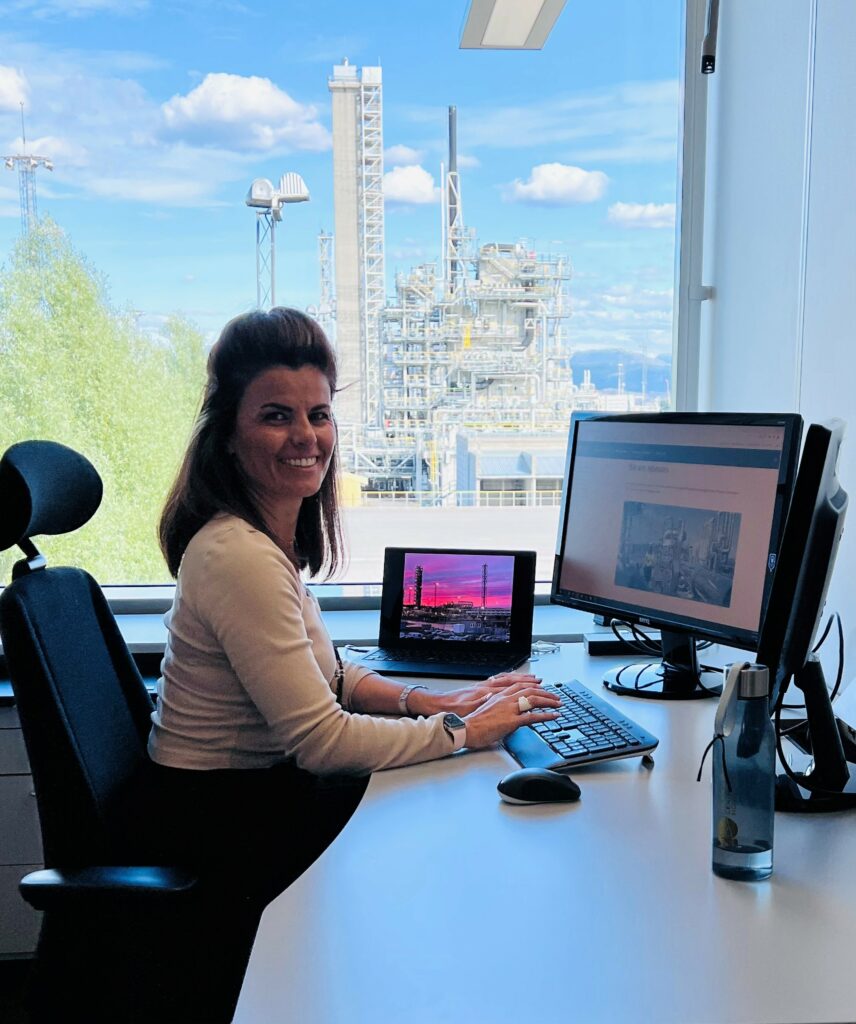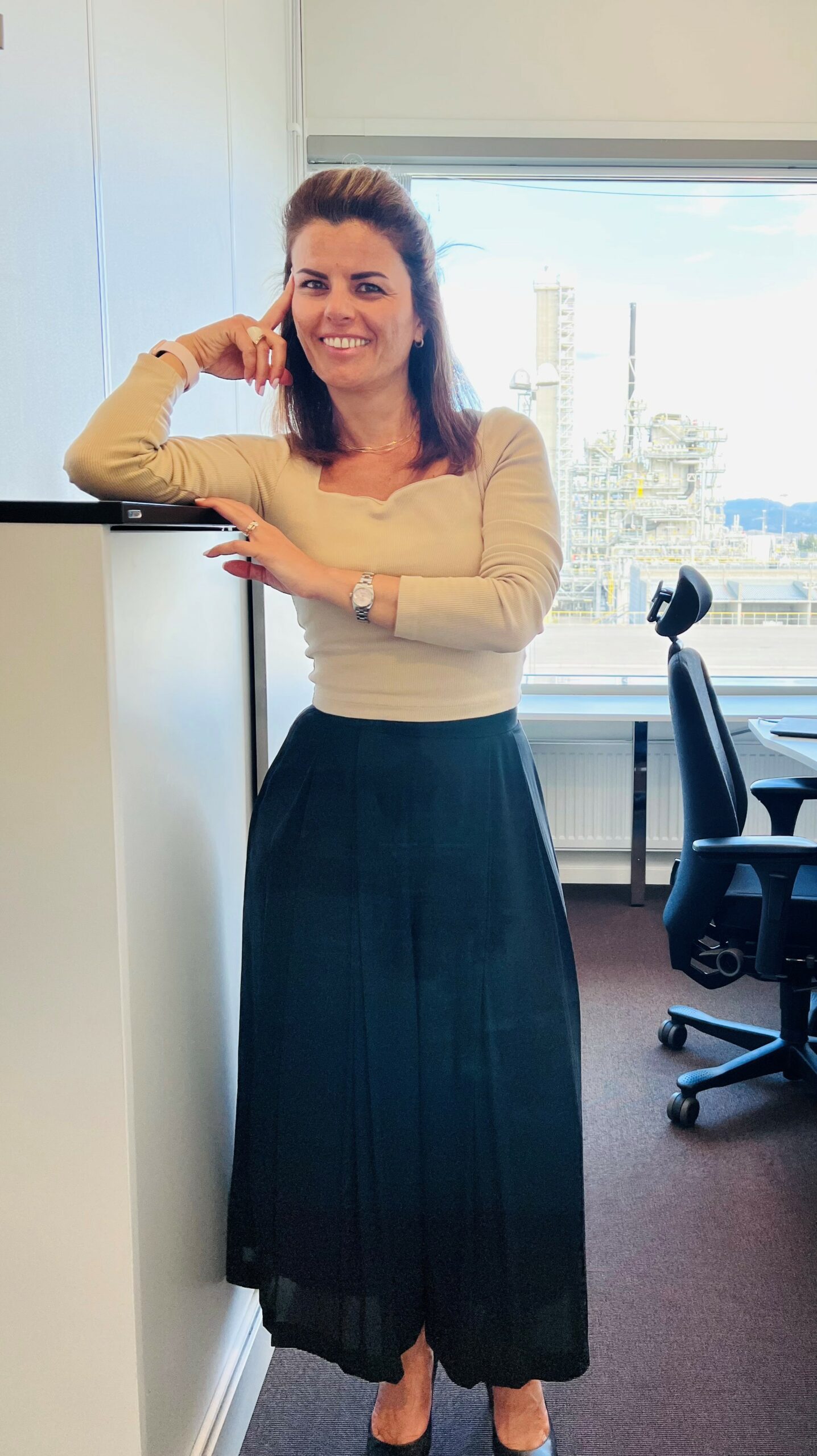21.09.2022
She got a dream fulfilled at TCM
Christina Martavaltzi joined the team last year as Advisory Services Lead. – A dream come true, says Martavaltzi.
2022 marks Technology Centre Mongstad’s (TCM) 10th birthday. We are celebrating by interviewing a range of people have made their mark on TCM over the last decade.

– Why did you apply for a position at TCM?
– When I first visited TCM back in 2013 as a member of the CO2 Abatement Research & Development team at Shell Global Solutions, I knew right away that I wanted to secure a role at Mongstad. On that visit, we discussed how to demonstrate a proprietary emerging capture technology. At the end of a packed day, there was no exhaustion – instead, I felt excited and motivated. A few days later, reflecting on the visit to TCM, I decided to make working there a career goal.
– Last year, Shell offered me the opportunity for a secondment, and I wasn’t going to let that pass me by.
– What were your first impressions of TCM in 2013?
– As impressive, exciting, and educational place to be. I’m a short Greek girl, and I remember trying to keep up with this tall Norwegian tour guide, trying to catch his every word.
– I couldn’t believe that after so many years in labs working with everything in miniature, I was now standing right next to a capture plant on an almost industrial scale! Obviously, I was following the exciting developments at the commercial CCS facilities that are using Shell technologies, but I’d never actually been up close and personal with a capture plant before then.
– I was also very lucky because the weather was unusually nice. I honestly couldn’t understand why people kept using comments about the weather as ice breakers. Now that I live here, I know! 😊
– What would you say is the most rewarding and interesting work you have taken part in at TCM since joining?
– The great thing about my job is that I’m at the centre of a team that is uniquely positioned to provide vital help to teams around the world who have ambitious plans to deploy carbon capture plants at their facilities. Every single time we receive enthusiastic feedback telling us that our support proved invaluable for the next phases of their projects and each time they come back to find out more from us, I know I have done my bit in helping the world to move a step closer to addressing climate change.
– What’s the most challenging thing about working at TCM?
– Its location, especially in winter. I really dislike driving in dark, but TCM is situated in a quite a rural area about an hour’s drive from Bergen where I live. That being said, I must admit that I do recognise that TCM is smartly located next to a refinery and power plant, which means we can utilise their flue gases and utilities for testing our technology under real industrial conditions.
– When you tell your friends and acquaintances about TCM, what do you emphasise as its most important aspect?
– That TCM is a powerful addition to our toolbox in the fight to reduce CO2 emissions. It is the only facility in the world that can support carbon capture technology developers in their efforts to fully de-risk their technology before commercialisation, and we are the only team in the world that can share the impartial expertise that is needed if technology buyers are going to make smart decisions independently.
– Looking back on 10 years of TCM, what should TCM employees past and present be most proud of?
– Back in 2006, the realisation that the technology and the financials were not mature enough for commercial scale applications lead to the decision to build a test facility to serve as the world’s centre of expertise in order to de-risk the technology. Since the opening its doors in 2012, TCM has – through a range of proprietary testing – contributed to creating a competitive commercial landscape by supporting key stakeholders as they de-risk their technology. TCM’s non-proprietary campaigns have also delivered invaluable knowledge to the scientific and industrial community, which has made it possible to overcome the barriers to deploying technology. Tackling key blockers such as emissions monitoring, emission permit process, operating with complex flue gases and of course reducing the cost of the technology are just some of the highlights on the list of TCM’s achievements over its first 10 years of operation.
– What are your hopes for TCM in the coming decade?
– I expect TCM to maintain its recognised position as the centre of expertise in amine carbon capture technology at engineering scale for years to come. I envision TCM’s task force growing its capabilities in emerging carbon capture technologies by deploying a series of both non-proprietary and proprietary testing campaigns at the emerging technologies site which launched last year.
Name: Christina Martavaltzi
Age: 45
Education: PhD in Chemical Engineering, Aristotle University of Thessaloniki, Greece
Marital status: Married
Afiliation with TCM: Lead Advisory Services since June 2021 (on secondment from Shell)
Present position: Lead Advisory Services at TCM
– You and your colleagues in Advisory Services are helping carbon capture initiatives both in Norway and abroad. Can you tell us about some of the projects you are focusing on?
– One of the main areas of focus for my team has been to provide support for “Longship”, which I believe is the biggest climate project ever undertaken by Norwegian industry, and with strong backing from the Norwegian Government. TCM provided Advisory Services to both of the primary capture projects encompassed in “Longship”. We provided expertise during early studies for the Hafslund Oslo Celsio Waste-to-Energy plant, for the full-scale project at Klemetsrud in Oslo, and we participated in the HAZOP assessment of the capture project at Heidelberg Cement’s Heidelberg Materials Brevik factory. We have also supported Statkraft, Kvitebjørn Varme and Hoegh LNG in a range of other important Norwegian CCS projects.
– TCM also provided advisory services to OGCI (Oil and Gas Climate Initiative), the USD $1 billion climate fund founded by the world’s largest energy companies. Examples of other projects that have requested TCM’s support have included Net Zero Teesside, Phillips 66 and SSE Keadby, all of which are leading projects in the British CCS sphere that are most promising.

